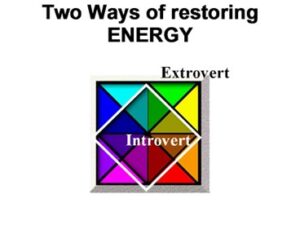
How to Understand People Introduction
“Know Thyself” is an ancient, an often repeated, maxim found engraved in a temple of Apollo in Delphi. If we want to truly know ourselves and how to understand people, we must also learn to understand other people too. There have been several important phycologist and counselors who have made great advances in understanding people. Sigmund Freud, and Carl Jung come to mind. There have also been a variety of Pop Psychology trends that have been helpful. For example, I’m OK, Your OK. There is also a long tradition of spiritual teaching and practices that are aimed at guiding people to attain more mature personalities. Ignatius Spirituality is one Practicing the Presence of God is another. The Enneagram is also a popular path.
Personality Type
I have found the study of Personality Type has been most helpful. The Myers-Briggs Type Indicator (MBTI) is a personality survey that can help one understand 16 distinct personalities. Some believe this can be too simplistic. However, there is plenty of room for nuance within each of the types. When you take the survey the result is given on 4 parameters in a range from 0-100. That leaves a lot of room for individuality. The parameters measure how we prefer to be energized, how we gather information, how prefer to decide and how we prefer to deal with the world.
Extroversion and Introversion
You are probably familiar with the terms Extroverted and Introverted. They describe how we choose to be energized. Both my late wife was and Brenda, my present wife, is INFP: Introverted, intuitive feeling perceptive. As a strong extrovert, I think I think out loud. Ask me a question and I start talking. Introverts on the other hand, think things over in their head before beginning to speak. It is important to understand this. If you are an extrovert and want to have a discussion with an introvert, you need to leave them space to think. It is even a good idea to suggest a topic to be discussed later. In social settings, extroverts will work the crowd. They will move around, amidst a group of people and talk to everybody introverts by contrast, prefer to deal with only one person at a time, if at all. Extroverts come to a party early and leave late introverts come late and leave early.
The Four Functions
Sensing and Intuition
The next 4 choices are called functions. We choose to gather data either with Sensing or Intuition. Everyone can and does use both. However, our preference makes us more skilled with one than the other. Dominate sensing people gather information directly with their senses. Dominate Intuitive types tend to gather information unconsciously and may not even be aware of how they come to conclusions. While a sensing person may notice how someone is dressed, they intuitive type is guessing their profession. Sherlock Holmes, the fictional detective, notices everything about a person. He deduces from things like their hands and fingernails or the water on their shoes where they have been what they have done what they were going to do. In contrast, the TV detective Colombo seems to know who did it from the beginning. He must work very hard to figure out how he knows.
 < click here for more information.
< click here for more information.
Feeling and Thinking
The same is true for the next pair., Feeling and Thinking. How we make decisions is this either with Feeling or Thinking. Obviously everyone uses both. You might consider the difference this way. Feeling wants to know what a good decision is and thinking wants to know what is the right decision. Feeling wants to know what will bring harmony. Thinking wants to know what is logical. For example, if your child wants to show your his drawing the thinking type person may notice a small imperfection and remark about it. A feeling type would be more likely to praise the child for his effort and creativity.
Judging and Perceiving
Judging and Perceiving are the next parameters in type theory. They reference how we deal with the world. They are really a choice between continuing to gather data and coming to a conclusion. Perceiving types go with the flow. Judging types feel better when decisions are made. Perceiving types may be criticized as procrastinating. Judging types may be criticized for jumping to conclusions. The best decisions are made with a balance of both. In my marriages, I have come to value the perceiving of my wives when it comes to making an important decision. They will gather all the relevant facts. If I wait for them to finish seeking information, I can then participate in helping us both come to a decision. Here is a small example, my late wife, Lily, would like to get greeting cards for various occasions. While she was searching through all the cards in the Hallmark store, I would wander around and not interfere. When I would come back to where she was, she would have three or four choices, and asked me which one I thought was best, In short order I would give my choice and she would agree.
Dichotomies of the Mind
As good as the MBTI and type theory is I found an enhanced way to understand Personality Type through the work of Walter Lowen. His groundbreaking book is Dichotomies of the Mind. It is my intent in this category of my website to introduce you to his theory and the significant advances he has made in Type theory. It is easy to understand, remember and apply to yourself as well as to help you appreciate the personalities of people you know. For example, Lowen observed and reasoned that each of the four Functions (Feeling, Intuition, Sensing, and Thinking) have preferences for input, numbers, time, and meaning. Sensing types prefer taste and touch for input. They prefer to deal with one thing at a time in the present and are always looking for fun. You can pick them out from their vocabulary. For example, they might talk about smooth sailing world, rough patch in their life. Feeling types for input prefer sounds tone and pitch. I they are seeking harmonious sounds they could be nostalgic for the past you can pick them out when they say things like he gives me a bad vibe. Intuitive types prefer the input of smelling and intuition. You could pick them out when they say something smells fishy or I have a hunch about that. They are constantly searching for meaning and can deal with an infinite number of things. Thinking types prefer the input of designs in patterns and edges. You might hear them speak about crooked people, or roundabout routes. When it comes to meaning they find it in history.
WORK, PLAY, CHALLENGE, and CREATIVITY
Lowen also is very descriptive about the relative effectiveness of conscious and unconscious activity that varies in each type between what he describes as Work, Play, Challenge, and Creativity. For example, my type, ENFJ in his theory is called a VERBALIST. The WORK made is the most conscious and willing to be accountable. In the PLAY mode I am a THEORETICIAN. I enjoy spending time with personality theory. In the. CHALLENGE mode is my enjoyment of sports. However, it is largely unconscious. When I try to think specifically about serving a tennis ball I get worse not better. In the CREATIVE mode I do things like Origami with my hands. I have created a few paper models, for example, a diamond ring for that from a dollar bill. Moreover, through this understanding of levels of conscious activity he shows how each of the MBTI Personality types are only the most conscious activity and we all use eight. Thus for example an INFP type’s play mode is like an INFJ. This will become clear when you read the post How to Understand People.
TRANSACTIONAL MODES
Lowen gives each of the 16 main types names he calls Transactional Modes. As I described in the above paragraph. For another example, INFP is named COMPOSER in the WORK mode and CRITIC in the PLAY mode. A COMPOSER loves to write. However, they use the same skills in composing flower arrangements, setting a table or planning a wedding. Both Lily and Brenda have kept volumes of journals. Brenda is currently composing the design and layout of our orchard in Arkansas. As you read through the posts How To Understand People you will come to a section devoted to each of the 16 types that graphically will show the WORK, PLAY, CHALLENGE, and CREATIVITY transactional rolls.
ENTROPY
 <click here for more info
<click here for more info
Lowen also uses the concept of entropy. You could think of this from the old phrase all work, and no play makes Jack and Jill dull people. He uses the example of the proverbial junk drawer in the kitchen. This is what happens in our mind when we do too much at the same thing. The PLAY mode reduces entropy in the WORK mode. The CHALLENGE mode reduces entropy in the PLAY mode. The CRATIVITY mode reduces entropy in WORK and PLAY. For example, after a long day of writing and thinking about Personality Type I WORK better after an exercise break in the pool. As you come to understand the various aspects of Personality Type you will be able to put them to use in your relationships at home, work, and leisure. This will help you to learn how to understand people and bring more harmony and peace into your life. You will be less likely to judge others, harshly, or berate yourself for less than perfect accomplishments in your more unconscious activities. You can also be encouraged to restore energy by changing your activities from time to time. I hope this introduction has peaked your interest and you will continue to read the post of this category of my website
Be sure to go to How to Understand People: Part 1 and read the whole detailed series!
For a personality test site click here.
 < lick here for more info
< lick here for more info